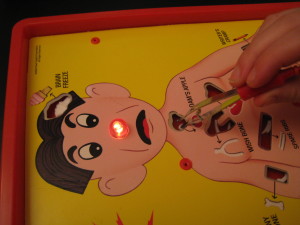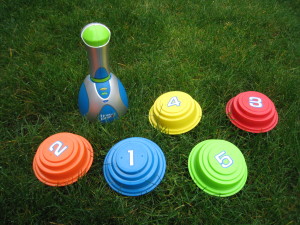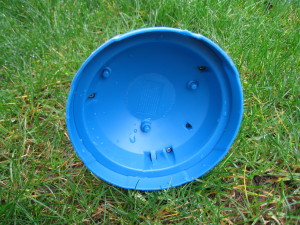A startup from MIT called “The Universe and More” is producing some excellent video games that engage the player in both fun and physics. Their first game was the Super Ultimate Graphing Challenge, in which the player reads a graph and identifies the position and velocity the object needs to have to match the graph. An iPad version is coming out soon. Their second game, Polarity Shift, is a re-make of the Pong game and helps the player gain experience with electric forces and fields. As players progress, they unlock new levels and characters.
Category Archives: Blog
SpillNot: The Physics Behind the Slosh
I recently received a free SpillNot through a promotion at Arbor Scientific. This really is a cool tool! With this device, you can carry a beverage or even swing it around in circles without spilling! It’s a great illustration of the effects of horizontal vs perpendicular acceleration on a cup of liquid and the physics of circular motion. Click on the link to see a video of the SpillNot in action and read an explanation of the physics behind it. My children were fascinated with this cool tool, though I have to admit that we did have a spill!
Pondering the Relative Size of Things in the Universe
I think it must be a uniquely human experience to contemplate and be awed by the vastness of the range of sizes of things in our universe. The two excellent resources mentioned in this post provide an opportunity to get a sense for this range. As I view them, I alternate between feeling very, very small when zoomed out to the scale of galaxies and feeling very, very large when zoomed in to the scale of atoms.
Powers of Ten is a classic film. As stated on the opening screen, “It is a film about the relative size of things in the universe and the effect of adding another zero.” The film begins by focusing on the scene of a picnic in Chicago, showing the size of a 1-meter by 1-meter square. Then every ten seconds, the view zooms out to show an area that is ten times larger than before. After zooming out past the Virgo cluster of galaxies, you are returned to the scene of the picnic where now you zoom in every ten seconds to see an area that is 10 times smaller than before until finally reaching the nucleus of a carbon atom.
The Scale of the Universe 2 is an interactive interface that allows you to explore the sizes of things on your own. You can zoom in and out to see things of different sizes, and if you click on an object a little information box pops up. How do Pluto and the United states compare in size? What is Gomez’s Hamburger, and how big is it? What is thinner – a piece of paper or a human hair? If you read the information boxes, you’ll find that the authors have a sense of humor –for an example check out the water molecule. There is truly a wealth of interesting information and comparisons to be discovered here. Enjoy!
To Predict or Not to Predict?
When children are taught how to do science inquiry, the process usually begins with an inquiry question followed by having the student make a prediction about what is going to happen. This approach often continues through high school lab science courses, even though in these inquiry situations students often do not have very much prior knowledge to base their prediction upon.
Having students make a prediction before doing the experiment certainly increases student engagement because they want to find out if they were “right,” but there are some drawbacks to this approach. One is that students who make a prediction that turns out to be “wrong” can feel a sense of failure. If a student repeatedly makes wrong predictions, she may develop a belief that she is not smart enough to do science or that she is not good at science. Students often do not have any real background knowledge of the phenomena being investigated, and so their sense of success or failure hinges on how lucky they were at correctly guessing the outcome of the experiment. A second drawback to having students make a prediction before carrying out an experiment is that it can skew their observations; what they expect to see can affect what they actually do see.
Investigative Science Learning Environments (ISLE) uses a different process to avoid these problems. The ISLE process starts with an observational experiment in which students make observations or collect data without a prior expectation about what will happen. From these observations and data, students look for patterns and come up one or more possible explanations, or hypotheses, that answer the questions “why” or “how”. These explanations need to be experimentally testable. The next step in the process is designing an experiment to test each explanation. Only at this point do the students make a prediction, which is based upon the explanation. Because the prediction is based directly on the explanation, it is the explanation that will be found to be right or wrong, not the student. In this case, the correctness of the prediction now reflects upon the correctness of the explanation, not the on the student personally. The experiment becomes a judge of how well the explanation fits the real world, not of how smart the student is. A prediction that turns out to be wrong can actually be exciting because it means that the there is something more to discover.
I really liked this approach, but thought there still was some value in having students give some initial thought to what would happen in an experiment, even when they don’t have very much to base it upon.
This month, at the Oregon AAPT meeting, Bradford Hill gave a presentation entited “Engaging Students through a Patterns approach to Physics.” His approach is to call the initial prediction a “wild guess.” The wild guess prediction is followed by inquiry to collect data, find a pattern, and then making a “Data-informed prediction” for a situation. This draws the students’ attention to the fact that our confidence about a prediction can vary, and that the the quantity and quality of data used to determine the pattern impacts the confidence that can be placed in the prediction that is based on the data. Calling the first prediction a “wild guess” frees the student from feeling that its correctness is a reflection of their intelligence or ability to do science.
Circuits in Games
The game “Operation” utilizes a simple electrical circuit to create an entertaining and challenging game. If the tweezers touch the metal surrounding the cavity holding the body part to be removed, a loud buzzer sounds the the little man’s nose lights up. Students can use their understanding of direct current circuits to figure out the circuit components and draw a schematic diagram showing their connections.
Another game that has some interesting switching to figure out is HyperDash. This game consists of a hand-held controller and five target disks. When the game begins, the controller calls out a color or number, and the player has to find the target and press the controller down onto the target. Somehow the controller “knows” whether you hit the right target or not. How can it tell?
On the bottom of the controller, there are three “buttons” that can be compressed. How could three buttons be enough to identify five targets? Are all the target shapes the same? What do you notice about the placement of the buttons on the controller?



